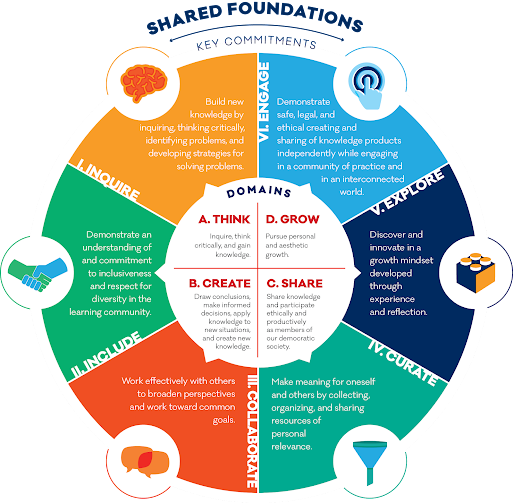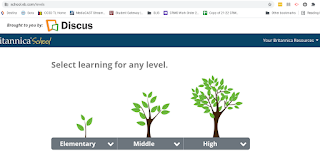Blogshare 2: Electric blogaloo (I'm sorry)
 |
Making is an inquiry-driven social activity that allows students to develop the very same skills, dispositions, responsibilities, and strategies touted in the AASL's 21st Century Standards. It opens the library to students who want to acquire, use, and share information in ways other than book-discussion groups or research writing.Makers... apply digital and manual skills to solve problems and create items that address their needs. Makers are problem solvers, idea dreamers; they tinker, hack, and customize products and materials to better serve them. Makers live out lifelong learning. They see a problem, something that isn't working for them, and they research ways to solve the problem and experiment, pushing the limits until they are satisfied. (Canino-Fluit, 2014, para. 3)
Makerspaces (or innovation labs, creation stations, hackerspaces, STEM hubs, fab labs, etc.; a rose by any other name, after all...) have the power and potential to inspire users to think, create, share and grow. Students who have access to these spaces and their contents in school are empowered to pursue the AASL Standards Shared Foundations, as Canino-Fluit asserts above, in dynamic and transformational ways that build upon the knowledge and skills they acquire from more traditional classroom education.
 |
| From AASL Standards Framework for Learners; standards.aasl.org |
By investing in the space, tools, technology, and continuing education required to operate an engaging and accessible makerspace, we are, in turn, investing in the future that our makers will go on to design and shape.
This investment is itself a challenge, and resource allocation in k-12 schools can prove a convoluted and fraught process for even fully funded and staffed districts. Population growth and needs, educational standards, and an evolving technology landscape are just some of the many factors that influence a school's budgetary constraints.
STEM Supplies is a company whose mission is to deliver "innovative products into the classroom to immerse students in STEM principles and to connect their learnings to the real world" (STEM Supplies, n.d.). The company also manages its own blog, with the aim of informing and supporting educators in STEM practices, techniques, and tools to facilitate this real world learning. They, too, understand that money, time, and expertise are finite resources in our schools, and have laid a fine foundation to guide teachers and librarians through the daunting process of funding, stocking, and managing a makerspace.
In 5 Tips for Writing Grants to Fund Your STEM Makerspace, middle school librarian Jessica Fitzpatrick shares her experience and insights from her work to demystify the process of grant writing for fellow librarians seeking funding for their own makerspaces. Grants are an invaluable way to fund special equipment or projects that do not fit into a school's limited budget, and the monies disbursed through grants (typically) do not need to be paid back! Applying for "free money" can seem daunting or even too good to be true, but Fitzpatrick breaks down the process into digestible steps that do not require extensive training or prior experience. Her steps are easy to follow, and she offers enough color and detail to be helpful without narrowing her focus or tips too exclusively.
There are also a handful of smart links embedded in the article that direct readers to various types of equipment for use in a makerspace, many of which STEM Supplies sells directly!
Regardless of whether you wish to purchase any equipment, the categories and item listings are a great resource to brainstorm for future makerspace activities and materials, as well as an easy way to learn what different products can do. For librarians intimidated by or unfamiliar with the process of applying, Fitzpatrick's post is a great primer on tackling that first application and developing confidence in pursuing future grants.
References:
CANINO-FLUIT, A. (2014). School Library Makerspaces. Teacher Librarian, 41(5), 21–27.
Fitzpatrick, J. (2019, May 2). 5 tips for writing grants to fund your STEM makerspace. STEM Supplies Blog. https://blog.stem-supplies.com/5-tips-for-writing-grants-to-fund-your-stem-makerspace/
Maker Media. (2013). Makerspace playbook: School edition.
STEM Supplies. (2019, May 14). About stem supplies. Retrieved March 23, 2022, from https://blog.stem-supplies.com/company/
TechFifteen. (2021, May 17). Makerspaces Summer [Video]. YouTube. https://www.youtube.com/watch?v=DWQ6B4UnZaA




Emily,
ReplyDeleteI love this for so many reasons! We all know how underfunded our schools are, so we have to find the money ourselves to enrich the lives and educational experiences for our kids. While the blog I found had tons of great low-budget/free ideas, I also enjoyed some of the ideas in Dr. Moorefield-Lang's presentation. However, as I watched the video, I'm glad she addressed the "where do we get the money for this" part since that really was what many of us were thinking. Some of these amazing kits, especially for more advanced robotics and programming tools, can be really expensive so it's necessary to know where we can go to get grant money to fund them. While I agree with her that kids, and educators, can do a lot with just cardboard and duct tape, I think it is important to give kids a wide range of choice so we can really see what they can do. I also really liked that quote from Canino-Fluit. In a world that is focusing more on problem-solving skills, the makerspace can be a great way for students of every ability level to learn new, employable skills. Great resource!
Cindy Hingle
Hey Emily!
ReplyDeleteI read the first section of your post and if I weren't already sold on makerspaces, I would be after reading the first few paragraphs of this post! I truly mean it when I say that I loved absolutely everything that you mentioned in this week's blog post! I love how you mentioned some of the factors that schools consider when thinking about adding a program like this because it felt as though you weren't giving the naysayers a second to speak why they shouldn't include a makerspace in the K-12 schools. You talked so highly about the article you shared that I had to take a look for myself and you are right! Writing grants can cause a bit of nervousness and stress, but Fitzpatrick does a wonderful job of breaking it down into steps that are easy to comprehend and don't contain an overload of information that could cause stress. I especially loved how she mentioned Strawbees in her post because that is what I did my blog post on this week. Great post and I look forward to seeing how you apply this information in the future!
Kersten Epting
Hey Emily,
ReplyDeleteYou have definity sold the idea of markerspace in the classroom and in the school. Some people dont understand the benefits that a makerspace has to offer. As you stated one benefit is that students become problem solvers. When students learn to be problem solver they can conquer the world.